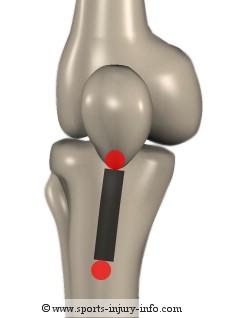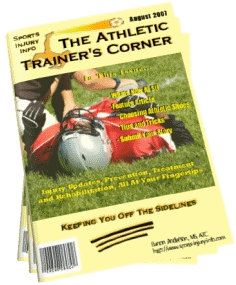ACL Reconstruction:
Patellar Tendon Graft

Choosing
the type of graft to be used for an ACL reconstruction can be a
difficult decision. You may or may not have a choice, depending on your
physician. Many use only one type of graft, either the patellar tendon
or the hamstring tendon.
The Patellar Tendon Graft

The patellar tendon is the connecting tissue for
the distal end of the quadriceps muscles.
It runs from
the patella to the tibial tubercle on the anterior tibia. Most patellar
tendons are about 30mm wide.
The
graft is harvested from an anterior incision on the knee.The graft from
the patellar tendon is taken from the middle third of the tissue,
usually about 10mm.
Small pieces of bone are taken
from both
the patella and the tibia, resulting in a graft that has small bone
plugs on either end.
The Benefits

The
greatest benefit of using a patellar tendon graft for an ACL
reconstruction is the fixation of the graft within the knee. The small
bone plugs on each end are the key to the excellent fixation.
When
bone heals, it regnerates itself, creating bone that is as good as the
original. When the graft is placed into the bone tunnels, it is secured
with small screws that wedge the graft into place.
As
the graft
begins to heal, the bone plugs are incorporated into the tibia and
femur, and the graft is securely fixed within the knee. Bone on bone
healing does not rely on hardware such as screws to keep the graft in
place after the first few weeks.
Other benefits of
the patellar
tendon graft for an ACL reconstruction is the make up of the graft
itself. The patellar tendon has been shown to stretch less than other
graft types in long term studies. This insures that the knee will
remain stable, with a tight graft. There is also a lower need to have
the fixation hardware (screws) removed after this type of ACL
reconstruction.
The Drawbacks
The biggest
drawback of the
patellar tendon graft is the fact that it disrupts the extensor
mechanism of the knee. By taking the middle third of the tendon, the
quadriceps and patellar tendon complex is weakened. The quadriceps are
an important part of the knee.
The insult to the
patellar tendon
has been thought to contribute to a higher incidence of anterior knee
pain after surgery, as well as the occurance of patellar tendonitis during
rehabilitation.
Range
of motion may be slower to return after a patellar tendon graft
reconstruction, as the knee is more painful due to the injury to the
patellar tendon and anterior knee.
ACL Surgery Stories
If you have had an ACL reconstruction, or are getting ready for this surgery, I want to hear your story. Whether you have questions you want answered, or just want to share your experience, this is the place for you.
Summary
The
patellar
tendon graft for an ACL reconstruction is a good choice for a strong
fixation and less stretching over time. It may have a higher pain
level, and range of motion may be slower to return.
Choosing
the
right graft should be discussed with your physician, and your concerns
should be answered before you enter into surgery.
Running Pain Solutions
Written for Runners by a runner, you'll learn a holistic approach to improving mobility, restoring normal movement and muscle activation patterns, and restoring the body and mind connection.
This Kindle Book contains a step by step program to keep you running pain free. Included are detailed instructions and illustrations for exercises to improve mobility, balance, neuromuscular control, strength and endurance. Only $7.49!
Get Your Copy Today!









